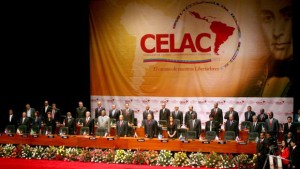Big Hopes for CELAC, but Little Outcome (At Least for Now)

The Community of Latin American and Caribbean States (CELAC) held its first summit on December 2 and 3 in Caracas, Venezuela. The group’s purported purpose is to create a deeper relationship among the countries of Latin America and the Caribbean, one that is able to function free of the all-pervasive daily political and economic influence coming from Washington. In fact, out of all the sovereign nations in the hemisphere, the United States and Canada are the only ones that are not scheduled to be included in the organization. For some of CELAC’s members, their far from hidden aims are to substitute membership in CELAC for their current reliance on the OAS. Presidents Hugo Chávez and Sebastián Piñera were appointed by the members of CELAC as its co-leaders, which could be an ironic development given that Chávez is maybe the most radical chief of state of the organization, and Piñera maybe its most conservative.
CELAC derives from a distinguished ancestry, namely the Rio Group, which was created in the late 1980s, in part as a move by major Latin American democracies, like Brazil, to produce a more integrated and effective group of Latin America and Caribbean nations. When the Rio Group held its 23rd annual meeting in February of 2010, the plan of a related institution operating completely independent of the United States and Canada was first discussed. This operation would be known as CELAC. The proposal of creating CELAC was a major hit, regardless of ideology, with leaders present at the Rio Group gathering, such as Evo Morales, Hugo Chávez, and Felipe Calderón. Even those dragging their feet over the new entity feel that there is no disputing that the group is a good idea for Latin America and the Caribbean: they have come together to discuss how to work more closely together; nevertheless, it was still being vigorously debated if the region will be better off, given the magnetic pull of the U.S. market, without maintaining prevailing close ties with the United States and Canada.
At CELAC’s first summit, Hugo Chávez declared that a Troika (trio) of countries would lead the organization. This body is to be made up of the country hosting the current summit, the country that will host the next summit and the country that had staged the previous summit. As of now, the Troika is composed of Chile, Venezuela and Cuba. The idea of a cluster of countries may work well in theory since it continually will depend upon the three to work in harmony in spite of ideological cross currents; such cooperation will circulate a reality that the host countries at a given summit hold a significant amount of power, and if every country eventually takes turn being a host, all of them will get a chance to be a leader, and because of the investiture of sober attention, can only attribute importance to its membership. However, in reality, the organization fails to take into account the real diversity of all the countries involved in the organization. For example, at the first summit Trinidad and Tobago pointed out that there were no countries in the Troika from the Caribbean. Without a leadership position in the Troika, how can these countries have any effective representation? Not only is there now great diversity among the countries in terms of location, but also in terms of how much disposable power they collectively, as well as individually, hold. This disregard for how much individual weight certain countries carry allowed for major players, such as Mexico, Brazil and Argentina, to realize that they will have only a limited voice at CELAC gatherings until it is their turn to host a summit event. Enraged by this idea, Brazil, Mexico and Argentina did not participate in day two of the summit.
As of now, some would have you believe that CELAC is nothing more than a seemingly anti-American organization that has failed to create a secretariat or anything else that could allow it to be a legitimate institution with concrete functions and a hand book of responsibility. There also remains the factor of whether its destiny is to lack the proper representation of all the countries involved. If CELAC wants to productively implement policies to solve major regional issues and eventually be a major player in the making of Latin American and Caribbean policy, it must first work on its fundamental structure. Chávez has stated “a giant was born” in reference to CELAC, but so far this giant might be in its more miniscule phase.
Para leer este análisis en español, haga click aquí.
To read more about CELAC, and similar Latin American and Caribbean organizations visit the following links:
A Historic Step to be Taken Today: Could UNASUR Finalize Plans for an Economic Emergency Fund?
Examina OEA Dividida la Crisis Hondureña

